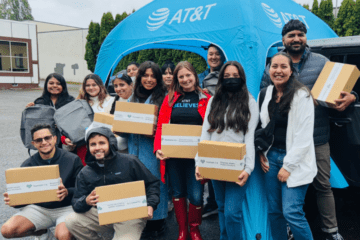It’s always great to reach a major milestone on an important project – and today we’re doing just that in industry and government’s shared effort to advance a more flexible and competitive approach to deploying wireless infrastructure.
We announced today a new collaboration with Ericsson to deploy, at scale, Open Radio Access Network (Open RAN) products at our cell sites. In addition to increasing our network’s efficiency and agility, this agreement creates a foundation that enables us to deploy hardware and software components from alternative vendors without undermining the performance of our already existing network. The result: We expect to move 70 percent of our wireless traffic to open infrastructure by 2026.
This isn’t just a win for AT&T – it’s a major step toward the federal government’s goal of getting more interoperable infrastructure deployed in American wireless networks. Over the last several years, there’s been a clear consensus from Washington in support of expanding the number of infrastructure options available to wireless operators at home and abroad. Just like the federal government’s decision to allocate taxpayer dollars toward this goal, we’re proud to be investing our own capital in the new infrastructure that will help meet Americans’ skyrocketing demand for ubiquitous mobile connectivity.
We’ve been very public about our support for Open RAN for some time, so let me key in on why today’s news is so important to advancing our deployment plan: Even as founding members of the O-RAN Alliance and the Open RAN Policy Coalition, we’ve been upfront about the challenges of making big changes to existing wireless networks without impacting the experience of millions of customers who rely on our services every day.
Deploying interoperable products from an incumbent vendor like Ericsson, however, helps us overcome that hurdle. It creates a trusted platform that will make it easier to incorporate products from alternative vendors down the road – and we are already in discussions with multiple vendors to incorporate their hardware and software into our network. Ultimately, by illustrating the feasibility of incorporating Open RAN interfaces from an incumbent vendor in an existing network, today’s announcement can spur momentum across the industry for further deployments here and abroad.
Another upshot of this endeavor is the creation of American jobs through expanded production of wireless networking equipment. Ericsson will use its recently expanded 5G smart factory in Lewisville, Texas to make 5G radios we will deploy in this effort — an output it expects will necessitate the creation of new jobs at the facility. Ericsson, whose state-of-the-art factory is fully powered by renewable electricity, also recently became the first mobile infrastructure provider to achieve compliance with the infrastructure law’s Build America, Buy America provisions.
Importantly, none of what we are announcing today would be possible without Ericsson’s meaningful actions this year toward creating an open ecosystem. The company now co-chairs three working groups in the O-RAN Alliance, which oversees the technical specifications for Open RAN products, and in September added support for open fronthaul across its Cloud RAN and radio portfolios. These developments, in concert with the effort we’re announcing today, illustrate the incumbent vendor’s commitment to providing interoperable products and will help create a more open ecosystem.
This collaboration is yet another way AT&T is investing to build the open internet and the kind of networks needed to support next-generation mobile applications. Perhaps more importantly, it’s an excellent illustration of the progress that can be made when sound, rational policy from government dovetails with industry’s desire to invest in modern infrastructure. It’s a win-win – and one we hope is a roadmap for further alignment between Washington and industry on this and other policy issues over the coming months and years.




